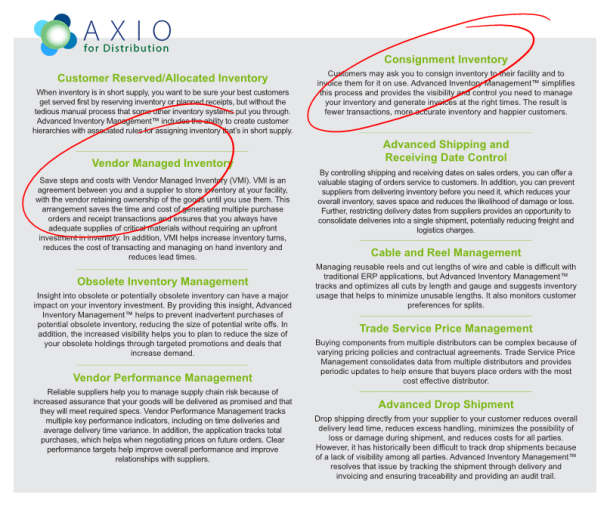This brief video demonstration is for current and prospective Microsoft Dynamics AX & Microsoft Dynamics 365 customers seeking an enterprise solution to assist vendor managed inventory.
For any warehouse or distribution business dealing with rotating inventory, supply chain management is critical. Being able to properly manage inventory can help your business increase margins and maximize warehouse space – which, you guessed it, boosts profits. This is easier said than done. Vendor managed inventory can be tricky because it isn’t always easy to transfer new inventory to a vendor managed inventory warehouse for future sale. In order to do this, you need a powerful and capable business solution.
AXIO for Distribution powered by Microsoft Dynamics 365/Dynamics AX is that solution. The Advanced Order Management module of AXIO for Distribution makes it easy for your employees to fulfill orders and transfer inventory for future sale and distribution. Warehouse workers can check on the exact product stock and assign a percentage/number of that stock to be moved to a vendor managed warehouse.
Watch as a Distribution expert guides you through the process of vendor managed inventory on AXIO for Distribution.



 Consulting experience. Half of his professional career has been in Manufacturing and Distribution from shop floor and warehousing positions to management. During this time he implemented ERP, DRP and Logistics solutions as internal Project Leader. The second half of his career has been in consulting, product management, product development and both consulting and software sales. He has held positions as VP Of Industry Solutions, VP of Product Development, VP of Sales and Marketing and Global Practice Leader for companies like IBIS Inc., IBM, Janis Group, Metamor, Marcam Corp. and more. Presently he is responsible for Industry Product Vision for multiple ERP solutions at SBS Group USA.
Consulting experience. Half of his professional career has been in Manufacturing and Distribution from shop floor and warehousing positions to management. During this time he implemented ERP, DRP and Logistics solutions as internal Project Leader. The second half of his career has been in consulting, product management, product development and both consulting and software sales. He has held positions as VP Of Industry Solutions, VP of Product Development, VP of Sales and Marketing and Global Practice Leader for companies like IBIS Inc., IBM, Janis Group, Metamor, Marcam Corp. and more. Presently he is responsible for Industry Product Vision for multiple ERP solutions at SBS Group USA.






